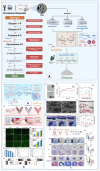Biomaterials in Postoperative Adhesion Barriers and Uterine Tissue Engineering
- PMID: 40558740
- PMCID: PMC12191503
- DOI: 10.3390/gels11060441
Biomaterials in Postoperative Adhesion Barriers and Uterine Tissue Engineering
Abstract
Postoperative adhesions (POAs) are a common and often serious complication following abdominal and gynecologic surgeries, leading to infertility, chronic pain, and bowel obstruction. To address these outcomes, the development of anti-adhesion barriers using biocompatible materials has emerged as a key area of biomedical research. This article presents a comprehensive overview of clinically relevant natural and synthetic biomaterials explored for POA prevention, emphasizing their degradation behavior, barrier integrity, and translational progress. Natural biopolymers-such as collagen, gelatin, fibrin, silk fibroin, and decellularized extracellular matrices-are discussed alongside polysaccharides, including alginate, chitosan, and carboxymethyl cellulose, focusing on their structural features and biological functionality. Synthetic polymers, including polycaprolactone (PCL), polyethylene glycol (PEG), and poly(lactic-co-glycolic acid) (PLGA), are also examined for their tunable degradation profiles (spanning days to months), mechanical robustness, and capacity for drug incorporation. Recent innovations, such as bioprinted and electrospun dual-layer membranes, are highlighted for their enhanced anti-fibrotic performance in preclinical studies. By consolidating current material strategies and fabrication techniques, this work aims to support informed material selection while also identifying key knowledge gaps-particularly the limited comparative data on degradation kinetics, inconsistent definitions of ideal mechanical properties, and the need for more research into cell-responsive barrier systems.
Keywords: biomaterials synthesis; biopolymers; bioprinting; electrospinning.
Conflict of interest statement
The authors declare no conflict of interest.
Figures












Similar articles
-
Gynecologic postoperative anti-adhesion barriers: From biomaterials to barrier development.Biomater Biosyst. 2025 Aug 5;19:100115. doi: 10.1016/j.bbiosy.2025.100115. eCollection 2025 Sep. Biomater Biosyst. 2025. PMID: 40809697 Free PMC article. Review.
-
Natural nanofibers for textile applications: A review on electrospinning of cellulose, chitin, and silk for sustainable functional materials.Int J Biol Macromol. 2025 Sep;321(Pt 4):146597. doi: 10.1016/j.ijbiomac.2025.146597. Epub 2025 Aug 6. Int J Biol Macromol. 2025. PMID: 40774495 Review.
-
How lived experiences of illness trajectories, burdens of treatment, and social inequalities shape service user and caregiver participation in health and social care: a theory-informed qualitative evidence synthesis.Health Soc Care Deliv Res. 2025 Jun;13(24):1-120. doi: 10.3310/HGTQ8159. Health Soc Care Deliv Res. 2025. PMID: 40548558
-
Improving biological and mechanical properties of bioprinted PCL-alginate-chondrocyte scaffolds for patellofemoral cartilage tissue regeneration.J Biomater Sci Polym Ed. 2024 Nov;35(16):2549-2569. doi: 10.1080/09205063.2024.2385182. Epub 2024 Jul 30. J Biomater Sci Polym Ed. 2024. PMID: 39078801
-
The use of Open Dialogue in Trauma Informed Care services for mental health consumers and their family networks: A scoping review.J Psychiatr Ment Health Nurs. 2024 Aug;31(4):681-698. doi: 10.1111/jpm.13023. Epub 2024 Jan 17. J Psychiatr Ment Health Nurs. 2024. PMID: 38230967
Cited by
-
Gynecologic postoperative anti-adhesion barriers: From biomaterials to barrier development.Biomater Biosyst. 2025 Aug 5;19:100115. doi: 10.1016/j.bbiosy.2025.100115. eCollection 2025 Sep. Biomater Biosyst. 2025. PMID: 40809697 Free PMC article. Review.
-
Head and Neck 3D Bioprinting-A Review on Recent Advancements in Soft Tissue 3D Bioprinting and Medical Applications.J Funct Biomater. 2025 Jun 30;16(7):240. doi: 10.3390/jfb16070240. J Funct Biomater. 2025. PMID: 40710454 Free PMC article. Review.
References
-
- Schaefer S.D., Alkatout I., Dornhoefer N., Herrmann J., Klapdor R., Meinhold-Heerlein I., Meszaros J., Mustea A., Oppelt P., Wallwiener M., et al. Prevention of peritoneal adhesions after gynecological surgery: A systematic review. Arch. Gynecol. Obstet. 2024;310:655–672. doi: 10.1007/s00404-024-07584-1. - DOI - PMC - PubMed
-
- Xu J., Fang H., Zheng S., Li L., Jiao Z., Wang H., Nie Y., Liu T., Song K. A biological functional hybrid scaffold based on decellularized extracellular matrix/gelatin/chitosan with high biocompatibility and antibacterial activity for skin tissue engineering. Int. J. Biol. Macromol. 2021;187:840–849. doi: 10.1016/j.ijbiomac.2021.07.162. - DOI - PubMed
Publication types
Grants and funding
LinkOut - more resources
Full Text Sources

